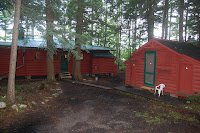 I've been reading Matthew B. Crawford's recently published book, Shop Craft as Soulcraft. Crawford holds a Ph.D. in philosophy from the University of Chicago and currently is a fellow at the Institute for Advanced Studies in Culture at the University of Virginia. He also owns and runs Shockoe Moto, a motorcycle repair shop in Richmond. His academic work (and sometimes mindless "white collar" jobs) coupled with his background as an electrician and mechanic have lead him to write this fascinating commentary on the nature of work, craft, and value in our society. Essentially, he argues that we've gone wrong in devaluing skilled manual work in favor of a "knowledge culture" in which young people are encouraged to educate themselves for jobs that will not require them to fix things or dirty their hands. Early in the book, Crawford lays out his intention:
I've been reading Matthew B. Crawford's recently published book, Shop Craft as Soulcraft. Crawford holds a Ph.D. in philosophy from the University of Chicago and currently is a fellow at the Institute for Advanced Studies in Culture at the University of Virginia. He also owns and runs Shockoe Moto, a motorcycle repair shop in Richmond. His academic work (and sometimes mindless "white collar" jobs) coupled with his background as an electrician and mechanic have lead him to write this fascinating commentary on the nature of work, craft, and value in our society. Essentially, he argues that we've gone wrong in devaluing skilled manual work in favor of a "knowledge culture" in which young people are encouraged to educate themselves for jobs that will not require them to fix things or dirty their hands. Early in the book, Crawford lays out his intention:In this book I would like to speak up for an idea that is timeless but finds little accommodation today: manual competence, and the stance it entails toward the built, material world. Neither as workers nor as consumers are we much called upon to exercise such competence, most of us anyway, and merely to recommend its cultivation is to risk the scorn of those who take themselves to be the most hardheaded: the hardheaded economist will point out the "opportunity costs" of spending one's time making what can be bought, and the hardheaded educator will say that it is irresponsible to educate the young for the trades....Crawford deplores the fact that cars we drive, the machines that sustain us, and the stuff we use is increasingly impervious to the understanding of a curious, mechanically competent ordinary person. Instead, they surpass our basic understanding and when broken must be repaired only by experts who have expensive equipment--or worse, must simply be replaced. Furthermore, as shop classes become rarer in schools, fewer and fewer people cultivate basic skills that would enable them to fix things. Crawford (like Mike Rose in The Mind at Work), argues that far from being mindless or merely mechanical, jobs requiring manual labor often require considerable intelligence, creativity, and ingenuity. There's a moral dimension to this too, which brings to mind Robert Pirsig's classic, Zen and the Art of Motorcycle Maintenance.
My own ideal day consists of a balance between what I think of as "head work" and "hand work." Having spent much of the morning reading, writing, and puttering at my computer, I look forward to this afternoon when I'll start a new woodworking project, building an easel. Particularly given my amateurish approach to such projects, it will challenge me with problems that I'll have to think hard about solving. I'll cut some pieces badly and drill holes in the wrong places and miscalculate some of my measurements. Still, I look forward to the challenge. For a while, I'll gladly immerse myself in the labor and the uncertainty that comes with it, knowing I'd never be able to make my living doing such work. I'll always be an amateur (from the Latin amator for "lover") in the original sense of one who loves the work even if he's in no way an expert.
~~~
New York Times review of Shop Class as Soulcraft
~~~
An Appreciation of Sei Shonagon's Pillow Book
~~~
On Zora Neale Hurston








